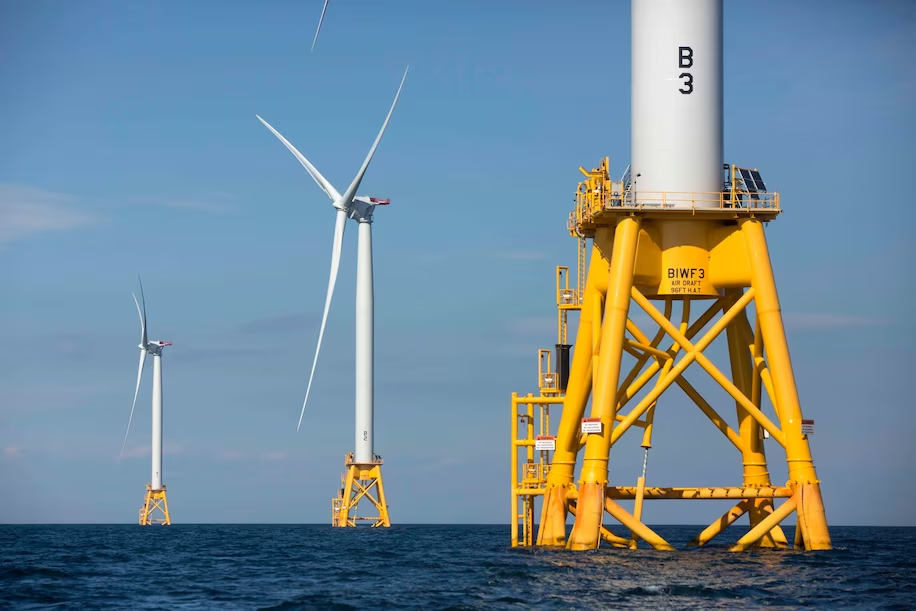Ocean Wind 1, which could power hundreds of thousands of New Jersey homes, is the Biden administration’s third approval of a large offshore wind energy project
The Biden administration gave a green light Wednesday to the largest-ever offshore wind project the U.S. has yet approved, paving the way for dozens of turbines that could eventually power hundreds of thousands of New Jersey homes.
The approval of Ocean Wind 1′s plan for construction and operations is a milestone for the project, which has faced fierce opposition from Republican lawmakers and residents in New Jersey. The project would be the state’s first utility-scale offshore wind farm and could power as many as half a million homes with clean energy, according to Orsted, the Danish energy company developing the project.
“The announcement of Ocean Wind 1’s Record of Decision today represents a pivotal inflection point not just for Orsted, but for New Jersey’s nation-leading offshore wind industry as a whole,” said New Jersey Gov. Phil Murphy, a proponent of offshore wind energy, in a release.
Construction is already underway on the other two large offshore wind projects approved by the Department of the Interior’s Bureau of Ocean Energy Management (BOEM).
The Vineyard Wind 1 project off Massachusetts and the South Fork Wind project off Rhode Island and New York are expected to generate about 800 megawatts and 130 megawatts of energy, respectively.
Ocean Wind 1 is the largest project of the three. Orsted projects that Ocean Wind 1 will deliver 1,100 megawatts of energy from up to 98 General Electric Haliade-X wind turbines placed approximately 15 miles off the coast of southern New Jersey. Orsted says the project could power approximately 500,000 homes, though BOEM has a slightly lower projection of roughly 380,000.
“The [approval] represents a critical step toward harnessing clean, renewable offshore wind to power New Jersey’s homes and businesses,” said Allison McLeod, the senior policy director of New Jersey League of Conservation Voters.
The Department of the Interior described the approval as a step forward for the offshore wind industry and as constituting “significant progress” toward the Biden administration’s goal of developing 30 gigawatts of offshore wind energy by 2030 in a release.
“The Biden-Harris administration has worked to jump-start the offshore wind industry across the country — and today’s approval for the Ocean Wind 1 project is another milestone in our efforts to create good-paying union jobs while combating climate change and powering our nation,” said Interior Secretary Deb Haaland in the release.
But to reach the administration’s climate goals, proposed wind projects up and down the East Coast will need to overcome steep obstacles, including opposition from Republicans and local residents. The resistance is especially fierce in Cape May County, where a number of coastal communities will be able to spot the wind turbines from the shore.
Residents have joined groups such as Protect Our Coast NJ to rally against the project on the basis of concerns ranging from the deaths of whales to the impact that the turbines could have on local tourism. These activist groups have taken legal action against the wind project.
The county has also enlisted lawyers in its effort to halt the offshore wind development. In June, the county voted to add an additional two law firms to its legal team to challenge federal regulatory decisions and the permits that the New Jersey Department of Environmental Protection issued to Orsted.
Former New Jersey Superior Court Judge Michael J. Donohue, who is serving as special counsel to the county, said Cape May County is reviewing BOEM’s decision and “will determine what avenues for legal challenges, if any, exist to pursue.”
In addition to legal challenges, Ocean Wind 1 has suffered from rising interest rates and inflation. The New Jersey legislature narrowly approved a bill last week to let Orsted keep federal tax credits in an effort to address what lawmakers described as lingering economic harms from inflation and the covid-19 pandemic.
Despite these setbacks, Orsted said in a release that with the BOEM approval, the project remains on track to begin onshore construction this fall and ramp up offshore construction in 2024. The project is expected to begin commercial operations in 2025, according to the company.

